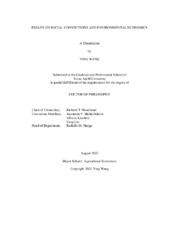| dc.description.abstract | To discuss the issues that may reduce social happiness, in this dissertation, I investigate the movement of social connections as wage increases, the impact of exogenous pollution on green innovation, and apply the synthetic control method to estimate the treatment effect of a short-period policy.
In the first chapter, I develop a model of social connections, in which players are required to share resources to establish social connections. In the basic model, I show that the equilibrium is not Pareto efficient by introducing a compensation mechanism, and showing that a Pareto improving trade could be made. I then show that if a wage increase for one player leads to a reduction in social connections, under some circumstances a mutually beneficial agreement could be reached in which the player foregoes the wage increase in exchange for a cash transfer.
Does environmental quality affect firms’ activities that might improve that quality? In the second chapter, I use China’s public heating policy as a quasi-experiment to investigate the impact of exogenous pollution differences on green innovation behavior. I use a regression discontinuity model, and carry out a suite of robustness tests. I consistently find that firms located in cities with an exogenous source of heavy pollution tend to adopt green innovation at a lower rate while we find no difference in the rate at which they adopt non-green innovation. I find a strong causal effect: being north of the boundary, where pollution levels are higher, leads firms to adopt less green innovation. Firms located in the heating areas report roughly 1 less green innovation per billion RMB of assets, a substantial difference given the average number of green innovations per billion RMB of assets of northern firms is 0.641.
In the third chapter, I use the synthetic control method to estimate the treatment effect of the environmental policy during the 2016 G20 Hangzhou summit. I estimate the treatment effects based on the different tiers of the policy implementation. Although the overall finding is not significant, I show that the synthetic control method is an appropriate method to estimate the cost from a short-period policy. | |


